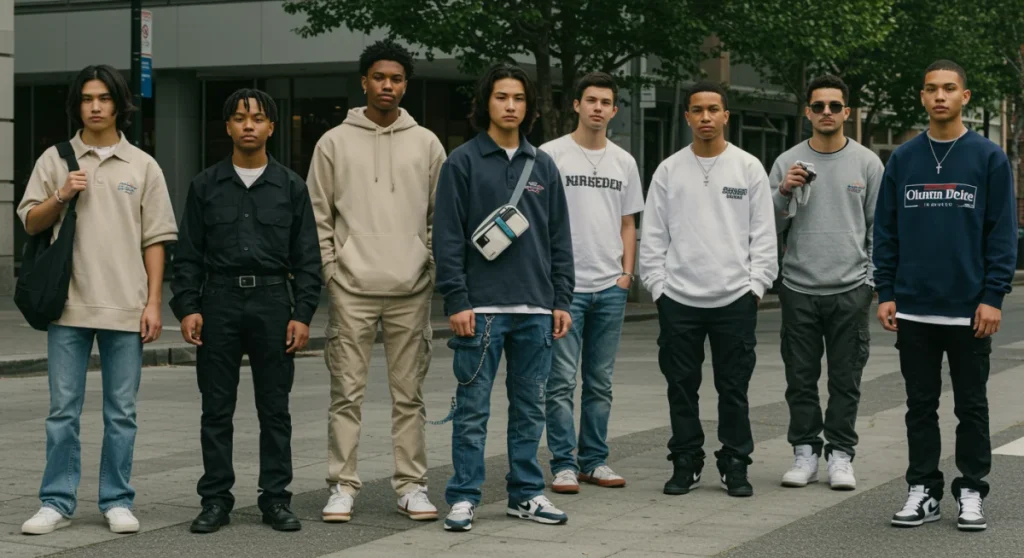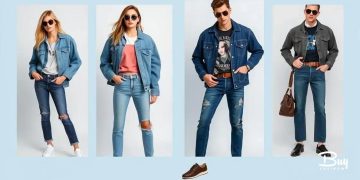Gen Z’s Influence: 7 Micro-Trends Reshaping US Fashion

Gen Z’s distinct values and digital fluency are rapidly redefining US fashion, pushing forward 7 key micro-trends that will dominate the industry over the next six months, emphasizing individuality, sustainability, and online aesthetics.
The fashion landscape is a constantly evolving tapestry, but rarely has a generation wielded such immediate and profound influence as Gen Z. In the coming six months, we anticipate a seismic shift in US fashion, driven by this digitally native, values-driven demographic. This article delves into Decoding Gen Z’s Influence: 7 Micro-Trends Reshaping US Fashion in the Next 6 Months, offering a comprehensive look at the styles, ethics, and digital behaviors that are setting the pace for what we’ll all be wearing.
The Rise of Conscious Consumption and Sustainable Style
Gen Z’s commitment to environmental and social causes isn’t just a talking point; it’s a fundamental aspect of their purchasing decisions, profoundly impacting fashion. This generation is acutely aware of the environmental footprint of fast fashion and actively seeks alternatives that align with their values. Their influence is pushing brands towards greater transparency and more ethical production practices, making sustainable style a non-negotiable.
The demand for eco-friendly materials, upcycled garments, and ethical labor practices is no longer a niche concern. It’s a mainstream expectation, with Gen Z consumers willing to invest more in brands that demonstrate genuine commitment to sustainability. This shift is forcing traditional retailers to re-evaluate their supply chains and marketing strategies, moving away from purely trend-driven consumption towards a more circular and responsible model.
Prioritizing Planet Over Profit
For Gen Z, the narrative around fashion has expanded beyond aesthetics to include the story behind the garment. They are educated consumers who research brand ethics and production methods before making a purchase. This scrutiny has led to a surge in popularity for brands that offer clear, verifiable sustainability credentials.
- Material Innovation: A growing preference for organic cotton, recycled polyester, hemp, and innovative bio-based fabrics.
- Upcycling and Repurposing: The embrace of vintage, thrifted, and upcycled clothing as a sustainable and unique fashion statement.
- Ethical Production: Support for brands that ensure fair wages, safe working conditions, and minimal environmental impact throughout their supply chain.
The movement towards conscious consumption is not merely a trend but a fundamental shift in how fashion is perceived and consumed. Gen Z’s collective power is reshaping the industry, demanding accountability and driving innovation in sustainable practices. Brands that fail to adapt risk becoming irrelevant in a market increasingly dominated by ethically minded consumers.
Digital Aesthetics and Virtual Wardrobes: The Metaverse Impact
As digital natives, Gen Z seamlessly integrates their online and offline identities, and fashion is no exception. The metaverse, NFTs, and virtual try-ons are not abstract concepts but tangible realities shaping their style choices. This micro-trend sees a blurring of lines between physical garments and their digital counterparts, influencing both real-world outfits and virtual self-expression.
The influence of digital aesthetics extends beyond virtual spaces. Fashion trends originating in gaming, social media filters, and augmented reality experiences are now translated into physical clothing. This reciprocal relationship means that what looks good online often dictates what is considered fashionable offline, creating a dynamic feedback loop for designers and consumers alike.
Gaming and Social Media as Style Catalysts
Platforms like Roblox, Fortnite, and TikTok are not just entertainment hubs; they are incubators for fashion trends. Skins, emotes, and avatar customization options provide a playground for self-expression, influencing real-world preferences for bold colors, futuristic designs, and comfort-driven styles. The viral nature of social media challenges and aesthetic movements further accelerates the adoption of these digitally-inspired looks.
The ability to experiment with outlandish styles virtually, without the commitment of a physical purchase, empowers Gen Z to be more adventurous with their fashion choices. This freedom fosters creativity and individuality, leading to a more diverse and experimental fashion landscape. The virtual wardrobe is becoming as important as the physical one, if not more so, for expressing identity.
The Resurgence of ’90s and Y2K Nostalgia, Reimagined
While nostalgia is a recurring theme in fashion, Gen Z’s take on ’90s and Y2K aesthetics is distinct. It’s not a direct copy-paste but a reinterpretation, blending elements from these eras with contemporary sensibilities and a strong emphasis on individuality. Think baggy silhouettes, vibrant colors, and playful accessories, but with a modern, often sustainable, twist.
This micro-trend is fueled by online archives, vintage finds, and a desire for authenticity that differentiates them from previous generations. They appreciate the history and storytelling embedded in older garments, giving them a unique appeal that mass-produced new items often lack. This re-imagined nostalgia is less about replicating the past and more about drawing inspiration to create something new.
Key Elements of Reimagined Retro
- Baggy Jeans and Cargo Pants: A staple from the ’90s, now embraced for comfort and versatility, often paired with more fitted tops.
- Cropped Tops and Baby Tees: A nod to Y2K, these are often seen with high-waisted bottoms, creating a balanced silhouette.
- Minimalist Accessories: While Y2K had maximalist tendencies, Gen Z often pairs nostalgic clothing with simpler, more understated accessories.
- Platform Shoes: From sneakers to boots, elevated soles add a playful yet edgy touch reminiscent of both eras.
The reimagined ’90s and Y2K aesthetic is a testament to Gen Z’s ability to blend historical influences with personal expression, creating a style that is both familiar and fresh. It’s a celebration of individuality within a recognizable framework, demonstrating their creative approach to fashion.
Gender-Fluid Fashion and Androgynous Silhouettes
Gen Z is a generation that largely rejects rigid gender norms, and this is profoundly reflected in their fashion choices. Gender-fluid fashion is not just a trend; it’s a fundamental expression of identity and inclusivity. This micro-trend emphasizes clothing that transcends traditional gender binaries, focusing on comfort, versatility, and personal style over societal expectations.
Androgynous silhouettes, oversized garments, and a blurring of traditionally masculine and feminine aesthetics are becoming commonplace. Brands that offer gender-neutral collections or market their clothing in a way that appeals to all genders are gaining significant traction. This shift is about liberating individuals from prescribed styles, allowing them to wear what feels authentic to them.
Breaking Down Fashion Barriers
The push for gender-fluid fashion is driven by a desire for self-expression without limitations. Gen Z consumers are looking for clothing that allows them to explore their identity freely, without being confined by outdated labels. This has led to a greater acceptance of styles that were once considered unconventional or exclusively for one gender.
- Oversized Everything: From blazers to hoodies, oversized garments offer comfort and a relaxed, gender-neutral aesthetic.
- Utility Wear: Practical and durable, utility pants, vests, and jackets are embraced by all genders for their functional appeal.
- Skirts and Dresses for All: A growing number of men and gender non-conforming individuals are incorporating skirts and dresses into their everyday wardrobes.
- Minimalist Jewelry: Simple, understated jewelry is popular across all genders, adding a subtle touch of personal style.
The embrace of gender-fluid fashion showcases Gen Z’s progressive worldview and their rejection of traditional societal constructs. It’s a powerful statement about inclusivity and the freedom to express oneself authentically through clothing, setting a new standard for the fashion industry.
The Rise of “Gorpcore” and Outdoor-Inspired Apparel
Gorpcore, a term derived from “Good Old Raisins and Peanuts” (a common trail mix), refers to the aesthetic of wearing practical, outdoor-inspired clothing in urban settings. This micro-trend, championed by Gen Z, blends functionality with style, prioritizing comfort, durability, and a connection to nature. It’s about looking ready for an adventure, even if you’re just heading to a coffee shop.
This trend reflects a broader cultural shift towards wellness, outdoor activities, and a desire for clothing that performs well in various environments. High-performance fabrics, utilitarian designs, and brands traditionally associated with hiking and camping are now mainstream fashion statements, often paired with unexpected elements to create a unique, urban-explorer look.

Blending Function and Fashion
Gorpcore is more than just wearing a puffer jacket; it’s an entire aesthetic that values practicality without sacrificing style. Gen Z appreciates the thoughtful design and technical innovation found in outdoor gear, incorporating these elements into their daily wear. This trend is also influenced by the growing popularity of hiking, camping, and other outdoor pursuits among younger generations.
- Technical Jackets: Waterproof, windproof, and breathable jackets from brands like Arc’teryx or Patagonia are styled for everyday wear.
- Cargo Pants and Utility Trousers: Practical pockets and durable fabrics are key, offering both style and functionality.
- Hiking Boots and Trail Sneakers: Rugged footwear is paired with both casual and more elevated outfits for a distinctive look.
- Fleece and Puffer Vests: Layering pieces that add warmth and texture, often in earthy tones or vibrant pops of color.
Gorpcore signifies Gen Z’s appreciation for gear that serves a purpose while also allowing for personal expression. It’s a comfortable, resilient, and stylish response to a fast-paced world, reflecting a desire for authenticity and preparedness.
Hyper-Personalization and DIY Fashion
In an era of mass production, Gen Z craves individuality, and hyper-personalization is their answer. This micro-trend involves customizing garments, accessories, and even footwear to reflect unique personal style. From DIY projects and upcycling old clothes to supporting independent artists who offer bespoke pieces, the emphasis is on owning something truly one-of-a-kind.
Social media platforms like TikTok and Instagram are hotbeds for DIY fashion tutorials and showcases, inspiring millions to pick up a needle and thread, paint, or fabric markers. This hands-on approach to fashion not only allows for unparalleled self-expression but also aligns with Gen Z’s sustainable values by extending the life of existing garments and reducing waste.
Crafting a Unique Identity
The appeal of DIY fashion lies in its ability to create a narrative around each piece. A customized jacket or a hand-painted pair of sneakers tells a story that mass-produced items cannot. This trend celebrates creativity and challenges the notion that fashion must be consumed rather than created.
- Custom Patches and Embroidery: Adding personalized touches to denim jackets, bags, and hats.
- Fabric Painting and Dyeing: Transforming plain garments into wearable art with unique patterns and colors.
- Deconstruction and Reconstruction: Taking apart old clothes and reassembling them into new, innovative designs.
- Jewelry Making: Crafting unique accessories from beads, found objects, or recycled materials.
Hyper-personalization and DIY fashion are powerful expressions of Gen Z’s desire to stand out and create their own trends. It’s a rejection of conformity and a celebration of individual artistry, making fashion a collaborative and constantly evolving act of creation.
The “Clean Girl” Aesthetic and Quiet Luxury
Contrasting with some of the bolder trends, the “Clean Girl” aesthetic and the emergence of “Quiet Luxury” represent a refined, minimalist micro-trend gaining traction with Gen Z. This style emphasizes well-groomed appearances, natural beauty, and high-quality, understated garments that speak of sophistication rather than overt branding. It’s about looking effortlessly polished and put-together.
This aesthetic is often associated with a healthy lifestyle, self-care routines, and an appreciation for timeless pieces over fleeting trends. It’s a rejection of excessive consumerism in favor of thoughtful, investment-worthy items that exude elegance through their quality and design, rather than their logo. The focus is on subtle details, clean lines, and a cohesive, elevated look.
Embracing Understated Elegance
The “Clean Girl” aesthetic isn’t about being flashy; it’s about meticulous attention to detail, from well-maintained skin and hair to perfectly tailored clothing. Quiet Luxury takes this a step further, focusing on premium materials and craftsmanship that are discernible to those in the know, without needing overt branding.
- Minimalist Wardrobe: A curated collection of versatile, high-quality basics in neutral tones.
- Tailored Silhouettes: Well-fitting trousers, blazers, and dresses that offer a sophisticated and polished look.
- Understated Accessories: Delicate jewelry, classic handbags, and quality footwear that complement the outfit without overpowering it.
- Groomed Appearance: A focus on natural makeup, healthy hair, and a clean, fresh overall presentation.
The “Clean Girl” aesthetic and Quiet Luxury demonstrate Gen Z’s multifaceted approach to fashion, showcasing their ability to appreciate both bold self-expression and refined elegance. It’s a mature and discerning style choice that values quality, longevity, and a subtle sense of sophistication.
| Micro-Trend | Brief Description |
|---|---|
| Conscious Consumption | Emphasis on sustainable, ethical, and transparent fashion choices. |
| Digital Aesthetics | Influence of metaverse, gaming, and social media on physical fashion. |
| Reimagined Retro | Modern take on ’90s and Y2K styles, often with sustainable elements. |
| Gender-Fluid Fashion | Rejection of gender norms, embracing androgynous and versatile clothing. |
Frequently Asked Questions About Gen Z Fashion
Gen Z’s strong emphasis on sustainability forces fashion brands to adopt more ethical production practices, use eco-friendly materials, and increase transparency in their supply chains. Brands that fail to meet these expectations risk losing a significant portion of this influential consumer base.
Social media platforms like TikTok and Instagram are crucial for Gen Z fashion. They serve as trend incubators, inspiration sources, and spaces for self-expression. Viral challenges, digital aesthetics, and influencer collaborations rapidly disseminate new styles and micro-trends across the globe.
Gender-fluid fashion appears to be a lasting shift rather than a temporary trend. It reflects Gen Z’s broader rejection of traditional gender norms and their desire for inclusive self-expression. This approach to clothing emphasizes comfort and personal style over outdated societal expectations, influencing design and marketing strategies long-term.
The “Clean Girl” aesthetic emphasizes a polished, minimalist look with natural beauty and high-quality, understated garments. It appeals to Gen Z for its focus on self-care, timeless elegance, and a subtle rejection of overt branding, aligning with their preference for authenticity and thoughtful consumption.
Gen Z reinterprets ’90s and Y2K nostalgia by blending retro elements with contemporary sensibilities and a focus on individuality. Unlike direct replication, they draw inspiration from past eras, often incorporating sustainable practices like thrifting and upcycling to create unique, personalized styles that feel both familiar and fresh.
Conclusion
The influence of Gen Z on US fashion is undeniable and rapidly accelerating. Their values-driven approach, digital fluency, and fierce individuality are not just creating new trends but fundamentally reshaping the industry’s landscape. From demanding sustainable practices and embracing gender fluidity to reinterpreting nostalgia and valuing hyper-personalization, Gen Z is setting a new standard for what fashion means. Brands that listen, adapt, and genuinely connect with these core principles will be the ones to thrive in the coming months and years, as this dynamic generation continues to define the future of style. The next six months will be a crucial period for observing how these micro-trends solidify and further evolve, cementing Gen Z’s role as fashion’s most powerful tastemakers.





